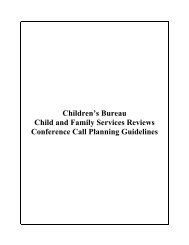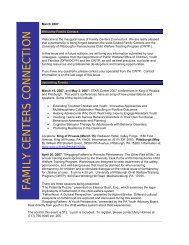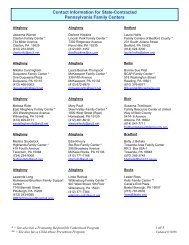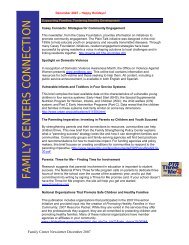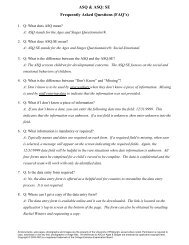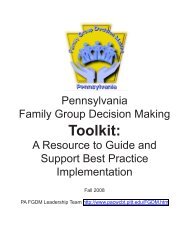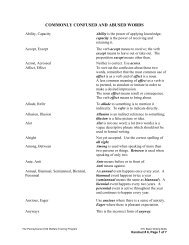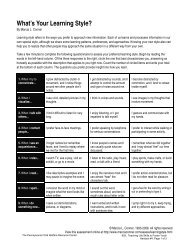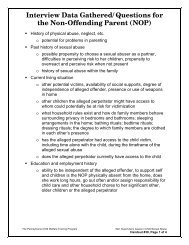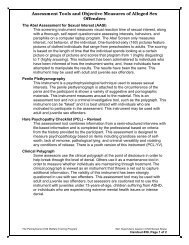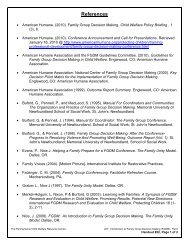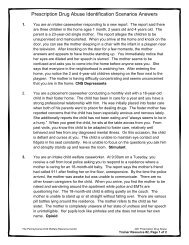Ages & Stages Questionnaires©: A Screening Tool - Pennsylvania ...
Ages & Stages Questionnaires©: A Screening Tool - Pennsylvania ...
Ages & Stages Questionnaires©: A Screening Tool - Pennsylvania ...
Create successful ePaper yourself
Turn your PDF publications into a flip-book with our unique Google optimized e-Paper software.
<strong>Ages</strong> & <strong>Stages</strong><br />
<strong>Questionnaires©</strong>:<br />
A <strong>Screening</strong> <strong>Tool</strong><br />
For <strong>Pennsylvania</strong>’s<br />
Child Welfare Workers<br />
1
OFFICE OF CHILDREN, YOUTH<br />
AND FAMILIES (OCYF) POLICY:<br />
Required for Child Abuse Prevention and<br />
Treatment Act compliance<br />
• Children under age 3, who have been the<br />
victims of substantiated abuse cases MUST be<br />
screened using ASQ/ASQ-SE within 30 days of<br />
case acceptance<br />
– Those with qualifying score must be referred for EI<br />
– Those who test normally must be screened<br />
periodically<br />
• Recommended for all children under age 5 in<br />
agency service<br />
2
Definitions<br />
• <strong>Screening</strong><br />
• Assessment<br />
• Evaluation<br />
3
<strong>Screening</strong>…<br />
• A brief process that sorts those<br />
who probably have problems<br />
from those who do not.<br />
• DOES NOT lead to a decision<br />
about whether a child has a<br />
developmental delay!<br />
.<br />
4
<strong>Screening</strong> helps to…<br />
• identify children who should<br />
receive more intensive<br />
evaluations through a<br />
specialized program:<br />
•Early intervention (EI)<br />
•Mental health/social service<br />
•Health systems<br />
5
6<br />
Assessment<br />
• Ongoing process through which<br />
appropriately qualified personnel,<br />
along with families, look at all areas<br />
of a child’s development in order to<br />
identify strengths and needs and to<br />
design a program that addresses<br />
the child’s developmental goals
Multi-disciplinary<br />
evaluation<br />
• An in-depth evaluation of one or<br />
more developmental areas to<br />
determine the nature and extent of<br />
a physical or developmental<br />
problem and determine if the child<br />
is eligible for early intervention or<br />
mental health services.<br />
7
Typically, when we think of<br />
“screening activities,” they<br />
are:<br />
Information Gathering activities:<br />
8
Tests don’t make decisions.<br />
People do!!!!<br />
(Neisworth and Bagnato)<br />
9
10<br />
Why screen?<br />
• <strong>Screening</strong> young children is an<br />
effective, efficient way for professionals<br />
to catch problems and start treatment<br />
when it does the most good—during<br />
the crucial early years when the child’s<br />
brain and body are developing so<br />
rapidly.<br />
http://www.zerotothree.org/site/PageServer?page<br />
name=ter_util_babybrainflash
• “Compensating for missed<br />
opportunities, such as the failure<br />
to detect early difficulties...often<br />
requires extensive intervention, if<br />
not heroic efforts, later in life.” —<br />
From Neurons to Neighborhoods<br />
11
Formal <strong>Screening</strong> <strong>Tool</strong>s<br />
• Are based on the performance of<br />
a representative norming sample<br />
of young children<br />
• Identify children who may have a<br />
developmental delay<br />
12
13<br />
Why the ASQ and ASQ:SE<br />
were chosen…<br />
• Can be completed by the child’s<br />
parent, caregiver and/or the child<br />
welfare worker<br />
• Series of questionnaires for children 3<br />
months to 5 years
15<br />
ASQ System: 2 Components<br />
• ASQ<br />
• ASQ:SE
Let’s look at the ASQ<br />
Divided into 5 developmental<br />
domains<br />
• Communication<br />
• Gross motor<br />
• Fine motor<br />
• Problem-solving<br />
• Personal-social<br />
16
17<br />
The ASQ<br />
• 19 questionnaires between 4 and<br />
60 months of age<br />
• English, Spanish, French & Korean<br />
versions available<br />
• Can be completed in 10-20<br />
minutes
18<br />
• Each questionnaire includes a checklist<br />
of 30 questions<br />
• And an Information Summary page<br />
includes a section for scoring and an<br />
area for recording general concerns.
• Items written at 4 th to 6 th grade<br />
reading level, illustrations included<br />
• Questions are in order from easy<br />
to average skill level<br />
• Questions alternate using male<br />
and female pronouns<br />
• Can be adapted for children who<br />
are from culturally and<br />
linguistically diverse backgrounds<br />
19
Adapting for Children who are<br />
Culturally and Linguistically<br />
Diverse<br />
• Potential Solutions<br />
• Omit the item and follow directions<br />
for scoring with unanswered<br />
questions<br />
• Substitute alternative items that will<br />
adequately assess the targeted skill<br />
20
A few key points about the<br />
tool…<br />
• Each questionnaire is valid for 1<br />
month before and after the indicated<br />
age. There is a 2-month window for<br />
use.<br />
• If a child was born more than 3 weeks<br />
premature calculate her “corrected<br />
age”. This can be done by adding the<br />
weeks of pre-maturity to the child’s<br />
date of birth. Use the child’s<br />
corrected age until the child is 24<br />
months.<br />
21
• User’s Manual- for more<br />
information<br />
• Suggested readings<br />
• Intervention Activities<br />
Sheets<br />
• Complete technical<br />
information<br />
©<br />
22
Scoring<br />
• Items are scored as:<br />
• Yes – 10 pts<br />
• Sometimes – 5 pts<br />
• Not yet – 0 pts<br />
Each response has a point value, total<br />
these values and compare the total<br />
score to the established cutoff<br />
points. Scoring can take as little as<br />
1 minute, no more than 5 minutes.<br />
23
24<br />
The <strong>Ages</strong> & <strong>Stages</strong><br />
Questionnaires:<br />
Social-Emotional©
The ASQ and ASQ:SE<br />
Relationship<br />
• ASQ:SE was<br />
designed to focus on<br />
the social and<br />
emotional behaviors<br />
of children<br />
• Should be used in<br />
conjunction with the<br />
ASQ or other<br />
screening tool<br />
25
ASQ:SE Focuses on<br />
• Social competence<br />
• The ability to engage in positive<br />
interactions with peers, siblings,<br />
parents and other adults<br />
• Emotional competence<br />
• The ability to effectively regulate<br />
emotions to accomplish one’s goals<br />
26
27<br />
ASQ:SE<br />
• Completed by the child’s parents<br />
or primary caregivers and/or the<br />
child welfare worker<br />
• Completed in 10-15 minutes
ASQ:SE<br />
• 8 questionnaires that can be used<br />
with children from 3 to 66 months<br />
of age<br />
• Questionnaires vary in length<br />
• English and Spanish versions<br />
available<br />
28
29<br />
ASQ:SE<br />
• Covers 7 areas<br />
• Self-regulation<br />
• Compliance<br />
• Communication<br />
• Adaptive<br />
functioning<br />
• Autonomy<br />
• Affect<br />
• Interaction with<br />
people<br />
• Includes general<br />
concerns area
30<br />
ASQ:SE User’s Guide<br />
What can you find in there?
31<br />
Let’s look at a questionnaire!<br />
• ASQ:SE 30 month questionnaire
32<br />
Scoring<br />
• Items are scored as<br />
• Most of the time – 0 points<br />
• Sometimes – 5 points<br />
• Rarely or never – 10 points<br />
• Parents/Practitioner can check each item<br />
if it is a concern- 5 points<br />
• Scores for each item are combined for a<br />
total score. A high score may indicate<br />
problems. Each questionnaire has an<br />
indicated cutoff score.
33<br />
Reminder:<br />
• The results from the ASQ and the<br />
ASQ:SE will not identify which<br />
children have delays and which do<br />
not. It simply suggests which<br />
children need to be referred on for<br />
further in-depth evaluation.
Discussing results with<br />
families<br />
• Share the completed screener with<br />
family<br />
• Listen to family’s perspective<br />
• Discuss the scoring section<br />
• On target- no need for referral<br />
• On the border- monitor and follow up at<br />
intervals per DPW policy<br />
• Beyond cutoff – discuss need for referral for<br />
further evaluation to Early Intervention<br />
• Together make a decision about next<br />
steps<br />
34
Making a referral<br />
• Who refers: worker must, if child is in<br />
custody; parent/caregiver may, if child<br />
is not in custody<br />
• Where to call – provide contact<br />
information to parent/caregiver<br />
• Parent permission to share information<br />
• Follow up to find out if child eligible<br />
35
Early Intervention is:<br />
• Free<br />
• Voluntary<br />
• A system of supports to the family<br />
and child in order to enhance the<br />
child’s developmental capacities<br />
36
37<br />
Early Intervention Evaluation<br />
• A comprehensive look at a child’s skills<br />
and behaviors in all five<br />
developmental domains by qualified<br />
professionals<br />
• Determines eligibility for further early<br />
intervention services<br />
• Makes recommendations to address<br />
areas of concern
Next steps:<br />
Implementation<br />
• Share this training with your staff<br />
• Decide how screening will be implemented<br />
• Who, when, how often, how will results be<br />
shared with families<br />
• Document your process in agency and/or<br />
parent handbook/manual<br />
• Before beginning to screen a child not in<br />
custody, get parent permission (see pg in<br />
manual for sample)<br />
38
Next steps and<br />
support for you…<br />
• What are your plans as you leave<br />
the session?<br />
• What support may you need to<br />
get started, or for follow up once<br />
you have started?<br />
39
Questions??<br />
Need assistance?<br />
Contact …<br />
Jennifer Murphy 484-955-8264<br />
jenmur@berksiu.org<br />
Dina Stipetic 412-728-6622<br />
dinsti@berksiu.org<br />
Jill Kachmar 717-346-0445<br />
jkachmar@state.pa.us<br />
40
…The end!<br />
41



